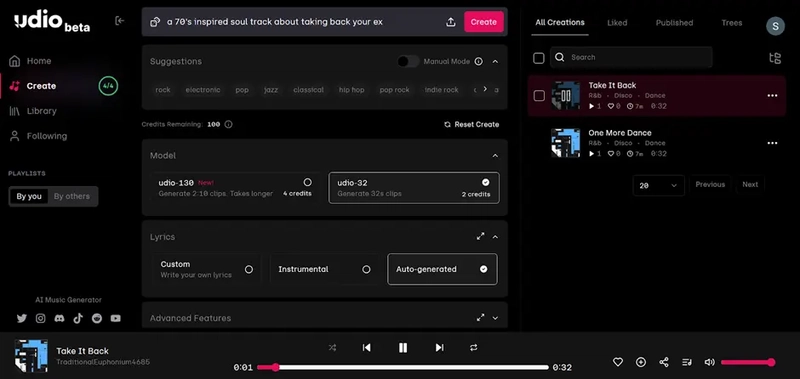Music production has evolved significantly over the years, and with the rise of digital tools, creating music has become more accessible than ever. One such platform that has made waves in the music production community is Udio. Udio is a cloud-based music production platform that combines simplicity with powerful features, enabling users from beginners to professionals to produce high-quality music. Whether you're a seasoned producer or just getting started, Udio offers a unique, user-friendly experience to bring your musical ideas to life.
In this article, we will explore how to create music using Udio, covering everything from the basics of getting started to advanced techniques for fine-tuning your compositions.
What is Udio?
Before diving into the specifics of how to create music using Udio, it’s essential to understand what Udio is and what it offers to its users.
Udio is an all-in-one music production platform designed to streamline the process of creating music from start to finish. The platform features a wide array of tools for composition, mixing, mastering, and collaboration. Udio's cloud-based nature means you can access your projects from anywhere, collaborate with other musicians in real-time, and share your work seamlessly.
Unlike traditional digital audio workstations (DAWs), which require you to install complex software on your computer, Udio is web-based and offers an intuitive interface that makes it easy for creators to get started quickly.
Key Features of Udio
- Cloud-based platform: Access your music projects from any device with an internet connection.
- Collaboration tools: Work with other musicians or producers in real-time, no matter where they are.
- Extensive sound library: Choose from a wide range of pre-recorded loops, samples, and instruments.
- Easy-to-use interface: Udio simplifies the music production process with drag-and-drop functionality and customizable workflows.
- Multi-Track Recording: Record multiple instruments or vocal tracks at once.
How to Get Started with Udio
Now that you have a basic understanding of what Udio is, let’s explore how to get started with music creation on the platform.
Step 1: Sign Up and Set Up Your Account
The first step is to sign up for an account on Udio’s official website. The platform offers both free and paid plans, with the free plan giving you access to a limited set of features. If you’re serious about producing music, however, you might consider upgrading to a paid plan for access to a broader range of tools and features.
Once you sign up and log in, Udio will walk you through an onboarding process that introduces you to the platform’s layout and essential tools.
Step 2: Create a New Project
Once you're set up, you can start a new project by clicking on the "New Project" button. You’ll be prompted to name your project and choose the initial settings, such as tempo, key, and time signature.
Udio allows you to choose from different project templates depending on the genre of music you want to create. Whether you’re working on electronic, hip hop, rock, or orchestral music, Udio provides genre-specific options to help you get started.
Step 3: Explore the Interface
Udio’s interface is designed to be intuitive, even for beginners. The workspace is divided into several key areas:
- Track area: This is where you’ll place your audio and MIDI tracks.
- Mixer: You can adjust the volume, panning, and effects of individual tracks here.
- Library: This section gives you access to Udio’s built-in sounds, loops, and samples.
- Editor: This area is for editing the MIDI and audio of your tracks.
The layout is clean, and tools are easy to find, which is a major advantage for people who want to focus on the creative aspects of music production rather than getting bogged down in complicated software interfaces.
What Tools Does Udio Provide for Music Creation?
Once you're familiar with the interface, it’s time to explore the tools that will help you craft your music. Udio offers a variety of tools and features designed to help you create, edit, and refine your music.
1. Sound Library and Instrument Selection
Udio boasts an extensive sound library, giving you access to a wide range of instruments and samples. Whether you’re looking for drum kits, basslines, synths, or even orchestral strings, you’ll find what you need in Udio’s library.
- Samples and Loops: Udio has thousands of royalty-free samples and loops that can be dragged and dropped into your project. These are great for laying down the foundation of your track, especially if you're working in genres like electronic music, hip hop, or pop.
- Virtual Instruments: Udio includes a selection of virtual instruments such as synthesizers, pianos, and drums that can be used to create melodies, chords, and rhythmic patterns.
2. MIDI and Audio Editing
Editing MIDI and audio is a crucial part of music production. With Udio, you can easily edit your tracks using the platform’s built-in tools.
- MIDI Editing: Udio allows you to write and edit MIDI in real time. You can use the piano roll or step sequencer to input notes, adjust timing, and tweak velocities.
- Audio Editing: Udio also allows you to import and manipulate audio files. You can slice, trim, and stretch your audio tracks, and even apply various effects like reverb, delay, and EQ.
3. Real-Time Collaboration
One of Udio’s standout features is its real-time collaboration capabilities. You can invite collaborators to your project, share your work with them, and make edits in real time. This is especially useful for producers who want to work with vocalists, instrumentalists, or other producers without the logistical challenges of coordinating studio time.
Collaboration in Udio is as simple as sharing a link to your project. Once your collaborators join, you can work on the same project, comment, and make changes in real time.
4. Built-in Effects and Plugins
To make your music sound professional, Udio comes with a range of built-in effects and plugins. These include EQs, compressors, reverb, delay, and distortion, which you can apply to individual tracks or the entire mix.
The platform also supports third-party plugins, meaning you can integrate your favorite VSTs and AU plugins into your Udio project.
How to Produce Your First Track with Udio
Now that we’ve covered the tools Udio provides, let’s go through the basic steps of producing your first track using Udio.
Step 1: Create a Basic Drum Pattern
Start by laying down a drum pattern using the Step Sequencer or Piano Roll. Choose a drum kit from the library and drag it into a new track. You can arrange the drums into patterns that form the backbone of your track. Experiment with different drum sounds to find the rhythm that matches the vibe you want.
Step 2: Add a Bassline
Once you have a solid drum groove, it’s time to add a bassline. You can use a synth bass sound or a live bass sample from the library. Add it to a new track, and experiment with different rhythmic patterns to complement your drums. Basslines add energy to the track, so be sure to experiment with note lengths and timing to create a groove that moves the song forward.
Step 3: Build the Melody
With the rhythm section in place, it’s time to create a melody. Use a virtual instrument, such as a piano, synth, or guitar, to lay down your lead melody. Experiment with different chord progressions, and keep refining your melody until it complements the rhythm and bassline.
Step 4: Add Additional Elements
Depending on your track, you may want to add extra elements like pads, vocal chops, effects, or additional percussion. Udio’s sound library is full of pre-recorded loops and samples that you can drag into your project to fill out the arrangement.
Step 5: Mix and Finalize Your Track
Once you’ve created all the elements of your track, it’s time to mix. Use Udio’s Mixer to adjust the levels of each track, apply EQ and compression, and add effects like reverb and delay to create depth and space in the mix. Don’t forget to automate volume, panning, and effects to add movement to the track.
Step 6: Export Your Track
When you're happy with the mix, you can export your track. Udio allows you to export in various formats, including WAV and MP3, making it easy to share your creation with others.
Can Udio Help You Master Your Track?
Yes, Udio offers tools to help you master your track. While mastering is a more advanced aspect of music production, Udio’s built-in mastering tools provide basic yet effective options for finalizing your track’s sound.
You can apply EQ, compression, and limiting to ensure your track sounds polished and ready for release. If you want to take mastering to the next level, Udio also allows you to export your mix and send it to a professional mastering engineer.
Related topics What’s Better, Suno or Udio?
For Developers: API Access
CometAPI offer a price far lower than the official price to help you integrate Udio Music API(model name: udio_music;), and you will get $1 in your account after registering and logging in! Welcome to register and experience CometAPI.
CometAPI acts as a centralized hub for APIs of several leading AI models, eliminating the need to engage with multiple API providers separately.
Please refer to Udio Music API for integration details and and Technical Details.
Conclusion
Udio is a powerful and accessible platform for music production. Whether you're a beginner looking for a straightforward way to start creating music or an experienced producer looking for a versatile tool that supports collaboration, Udio has the features you need. By following the steps outlined in this article, you can start creating professional-quality music from scratch, experiment with different sounds and techniques, and collaborate with others to bring your musical ideas to life.
With its cloud-based functionality, easy-to-use interface, and robust set of tools, Udio is a fantastic option for musicians looking to make their mark in the digital music world. So, go ahead, start your project, and see what you can create using Udio today!





Top comments (0)